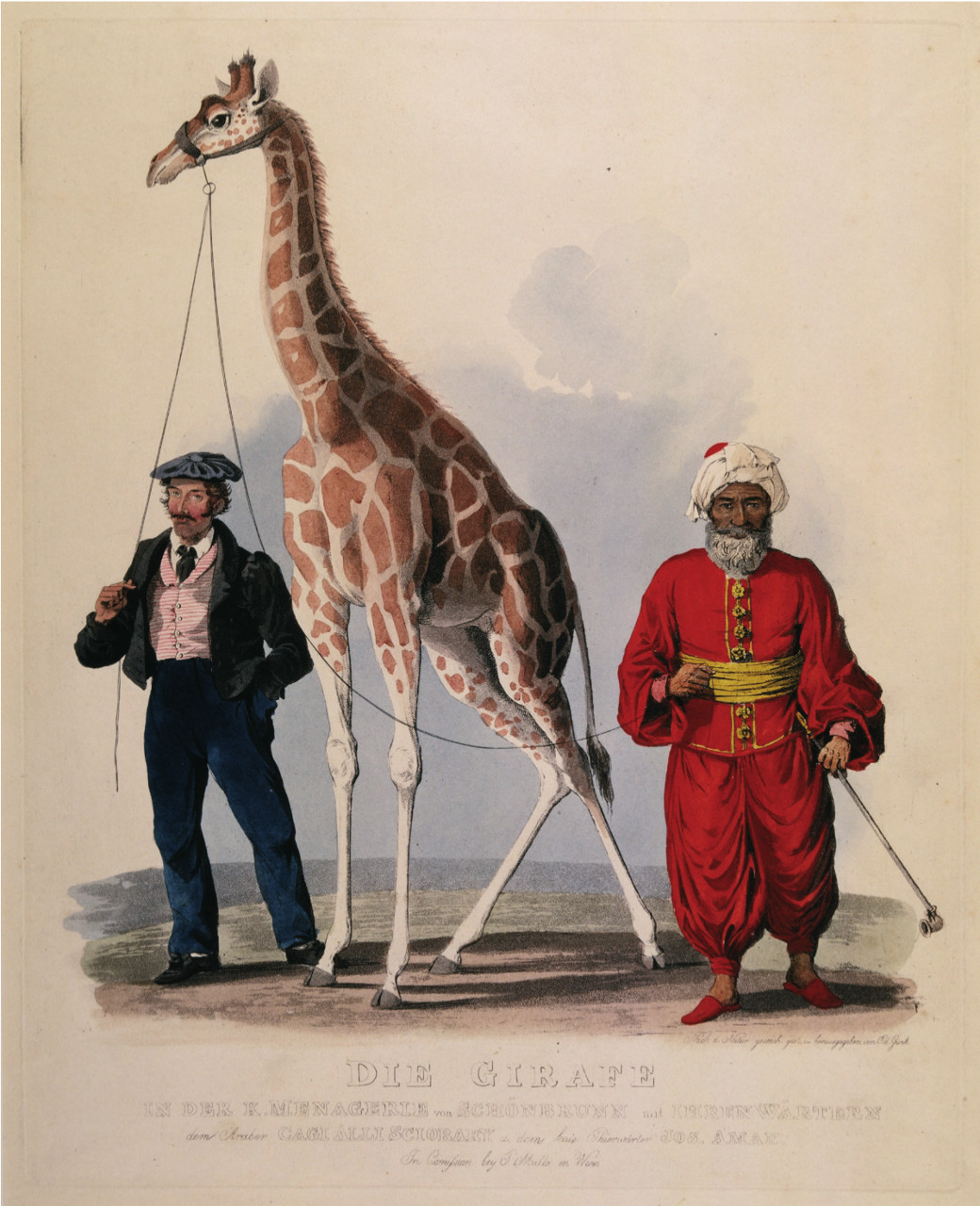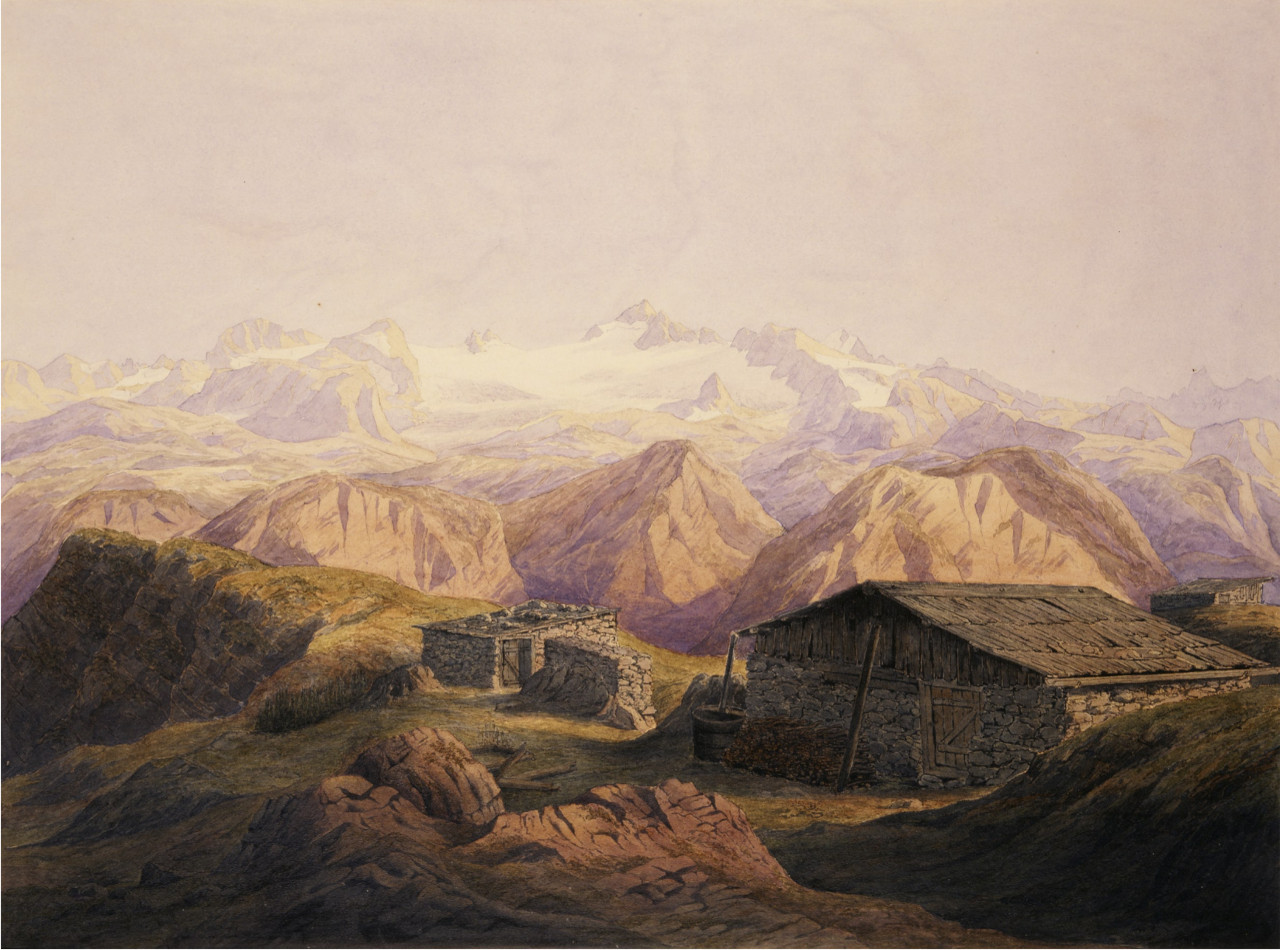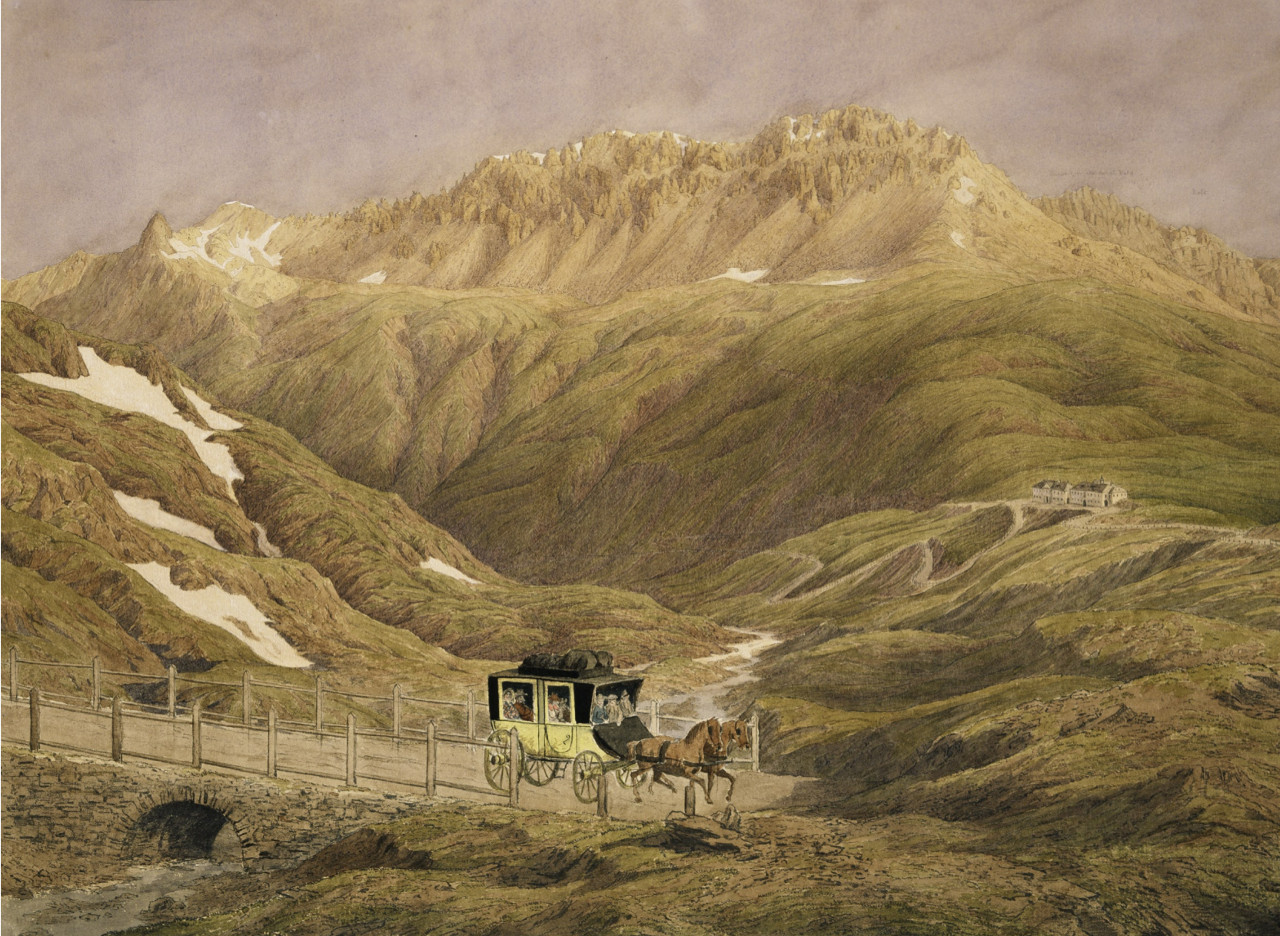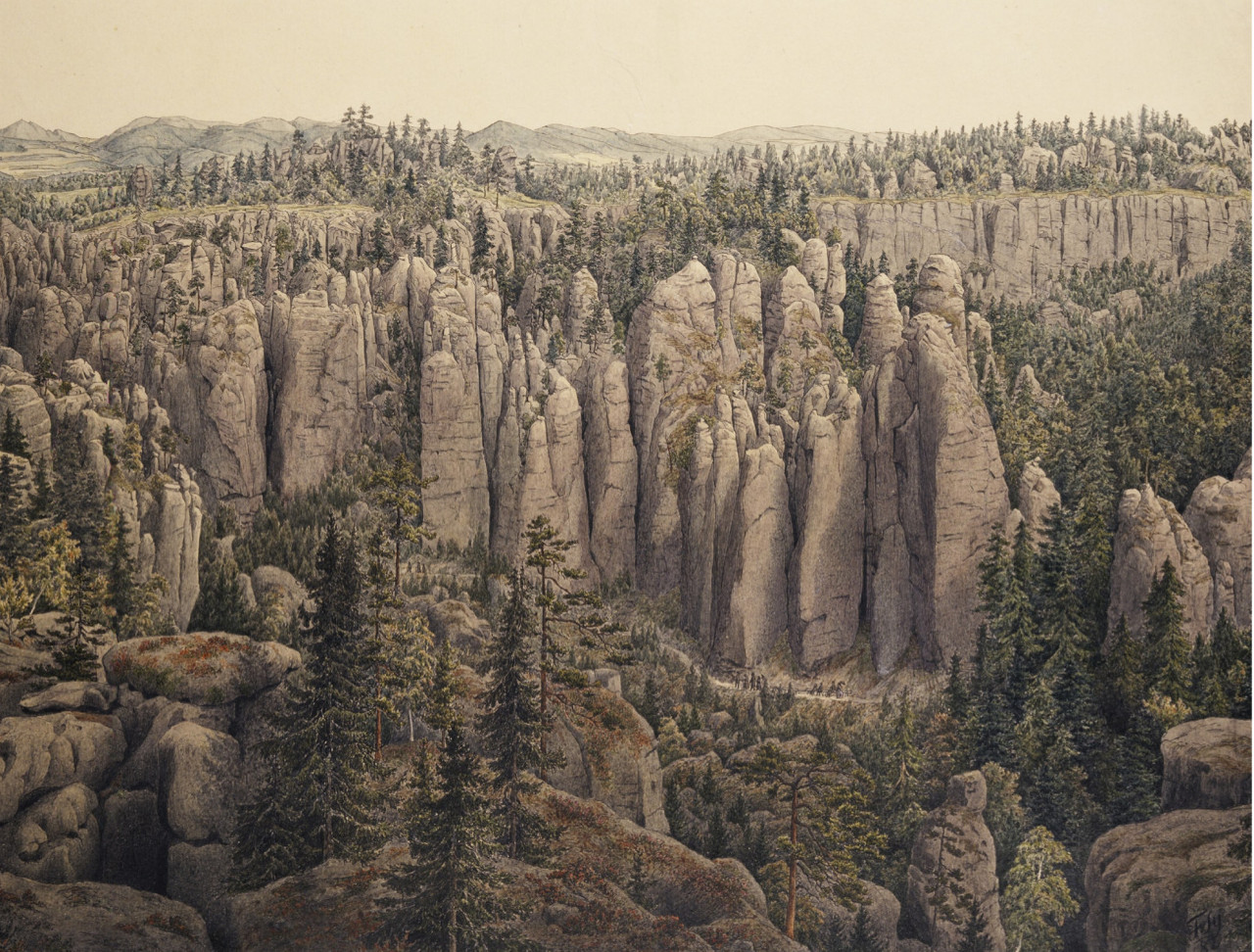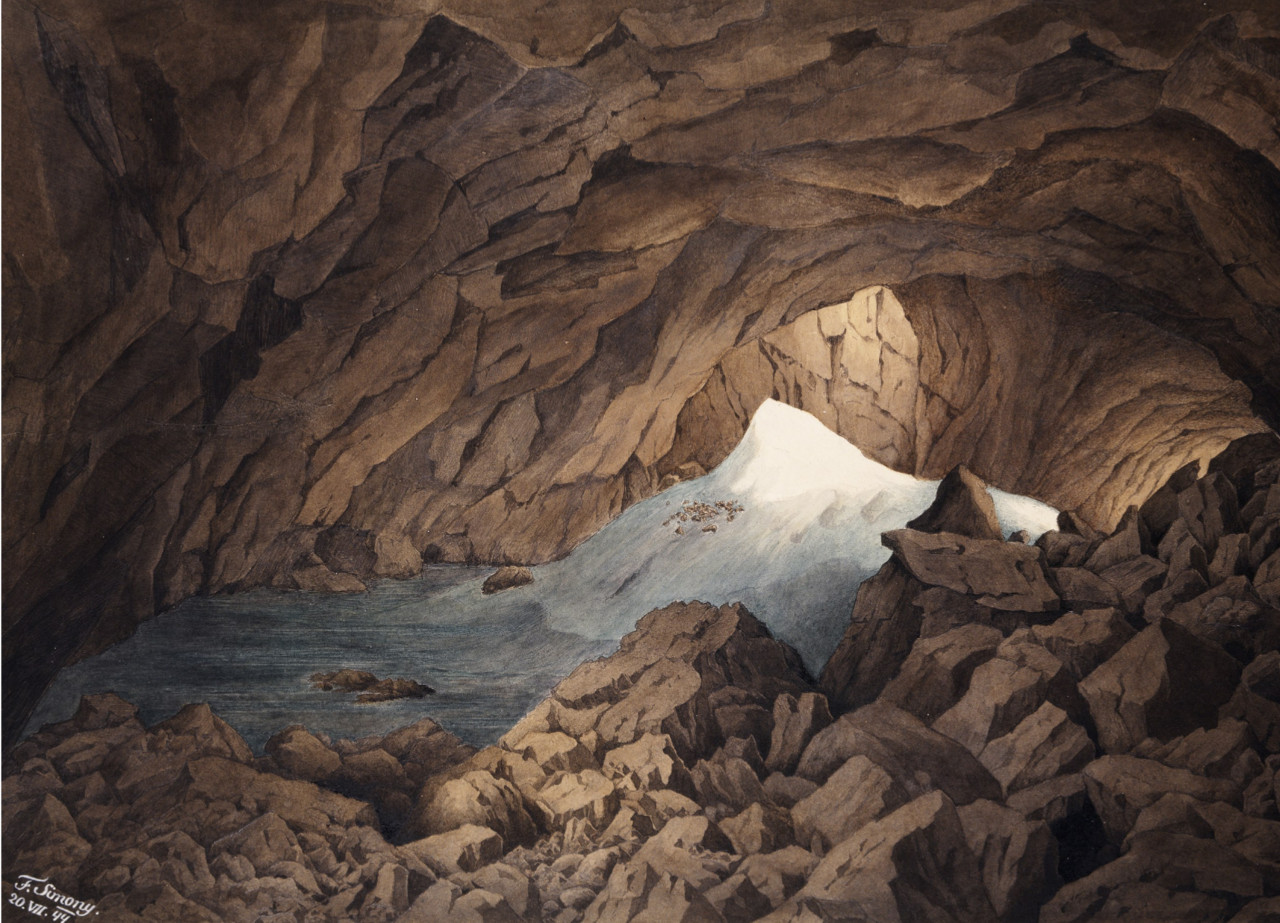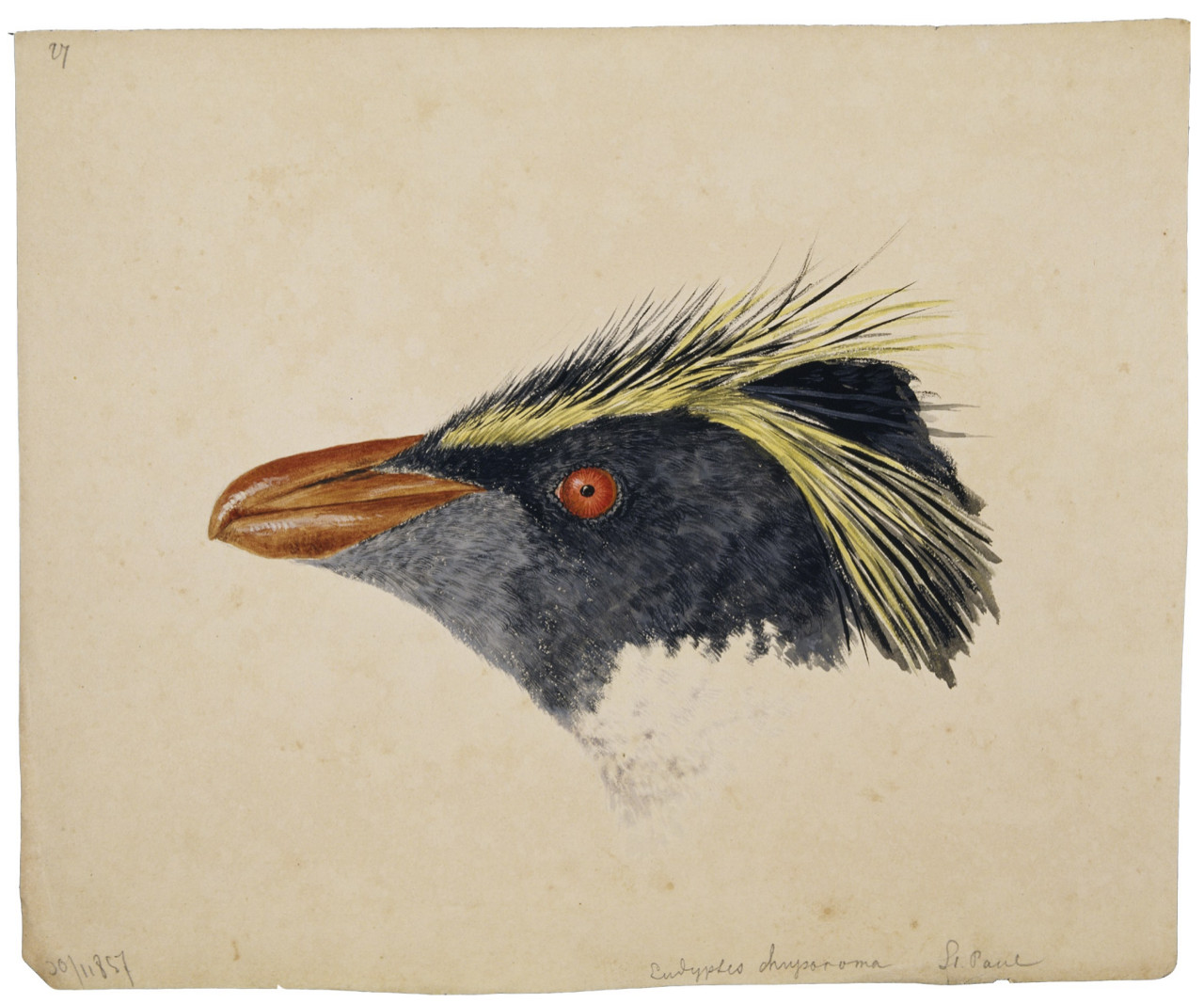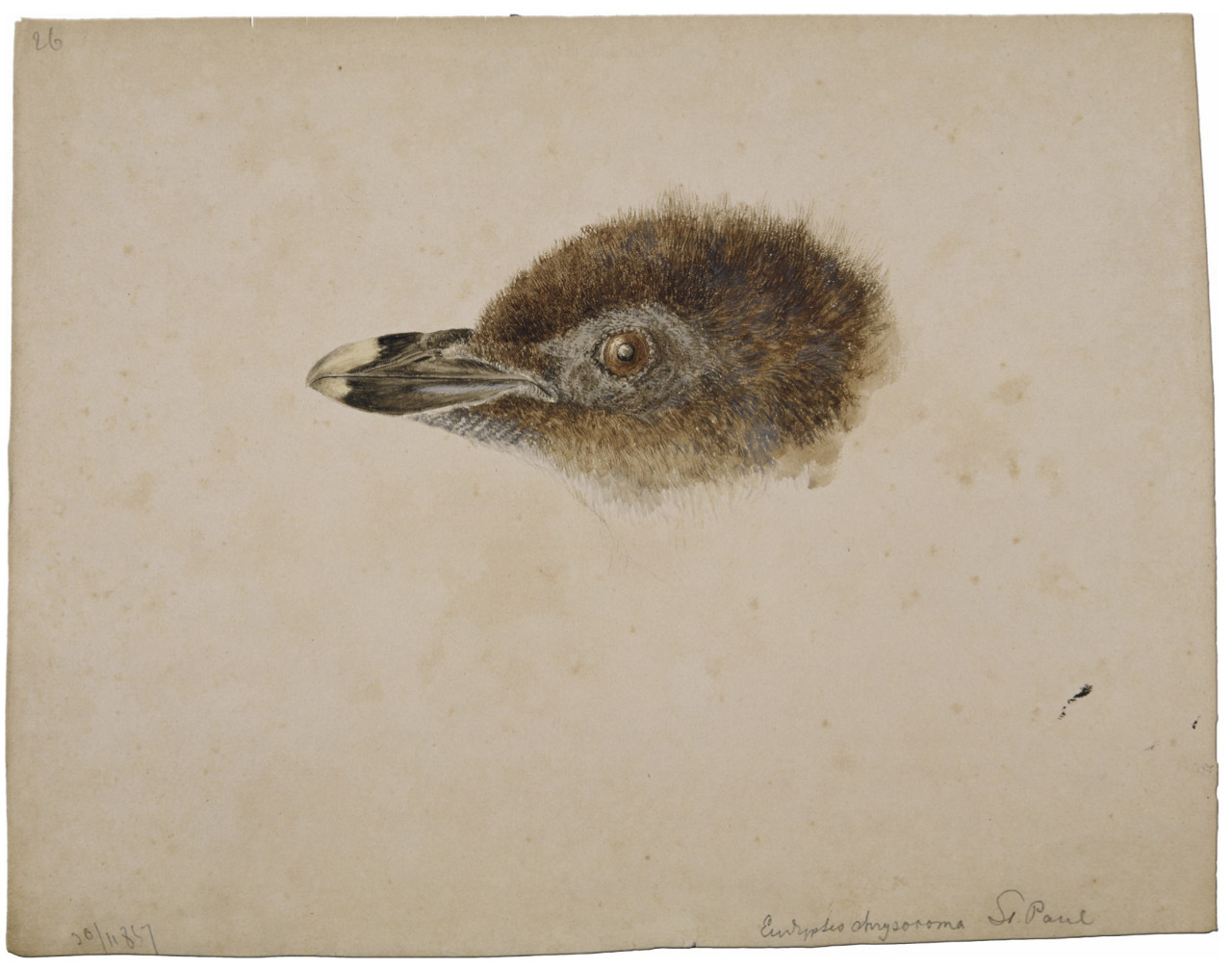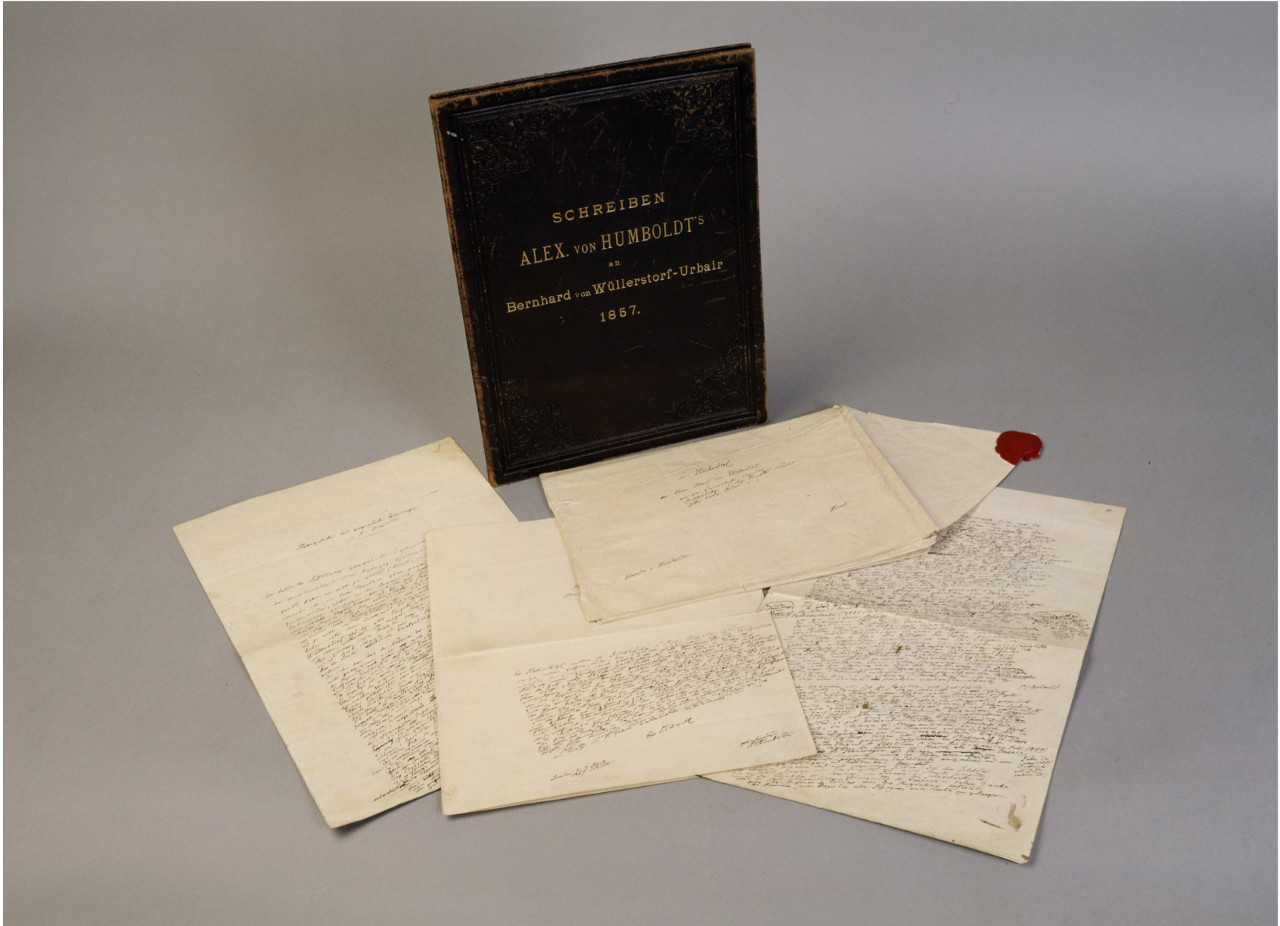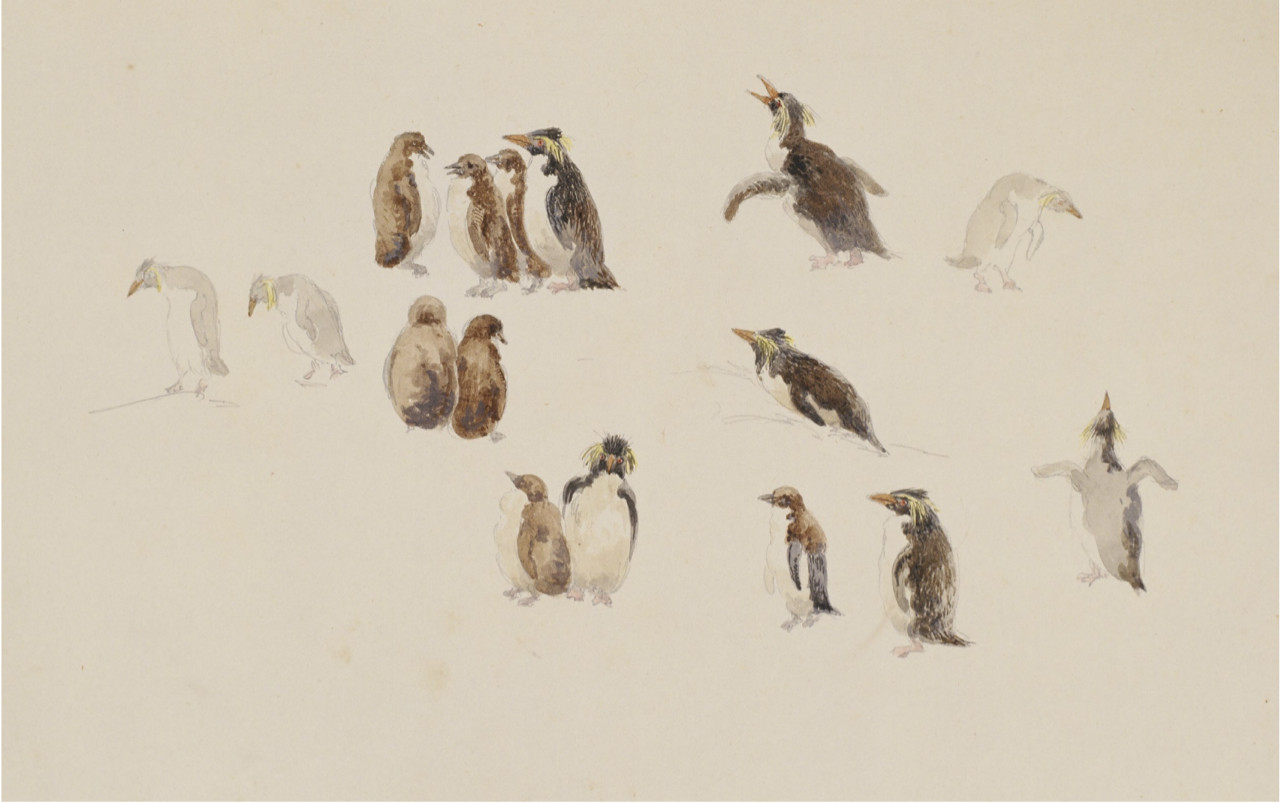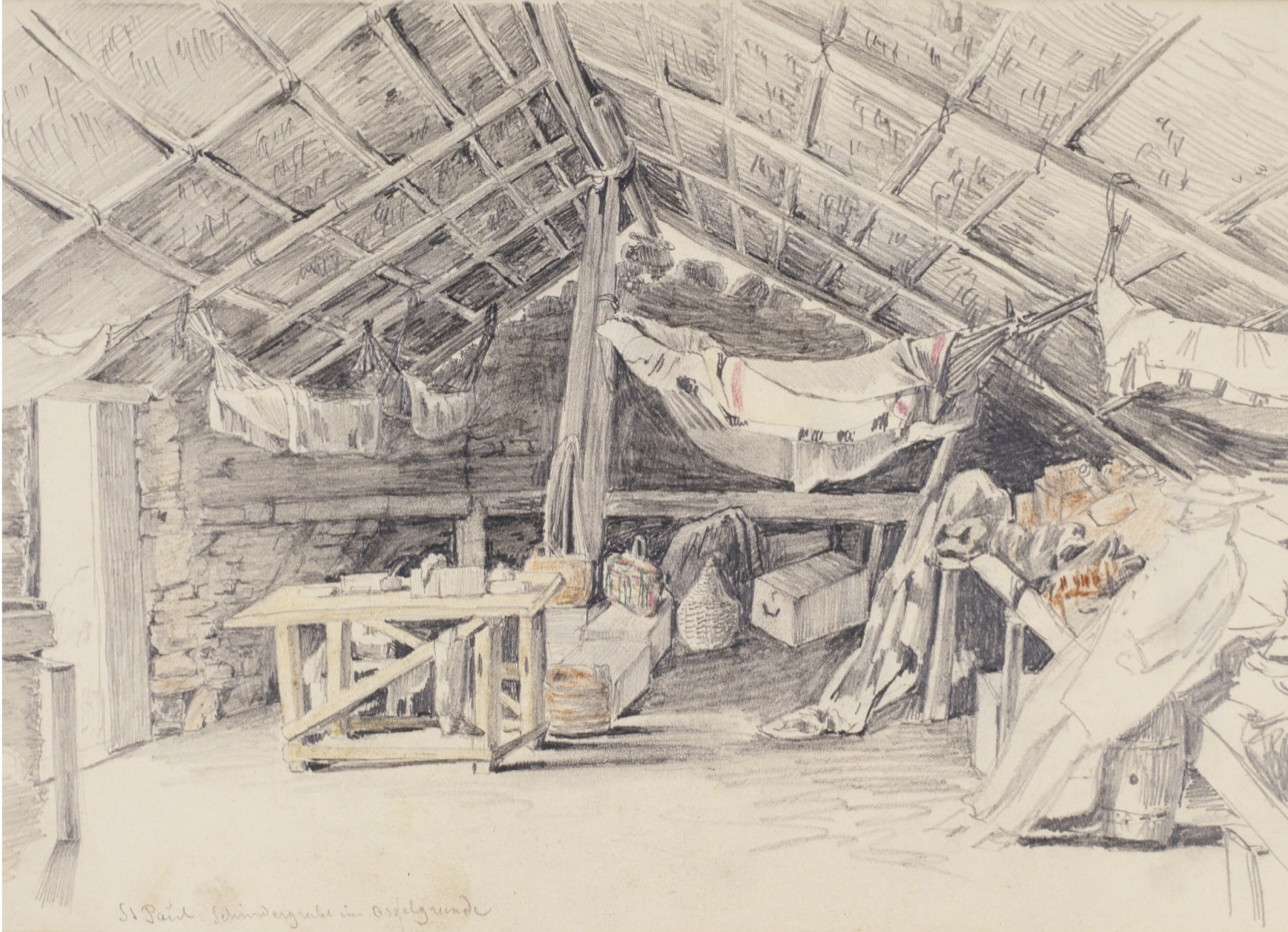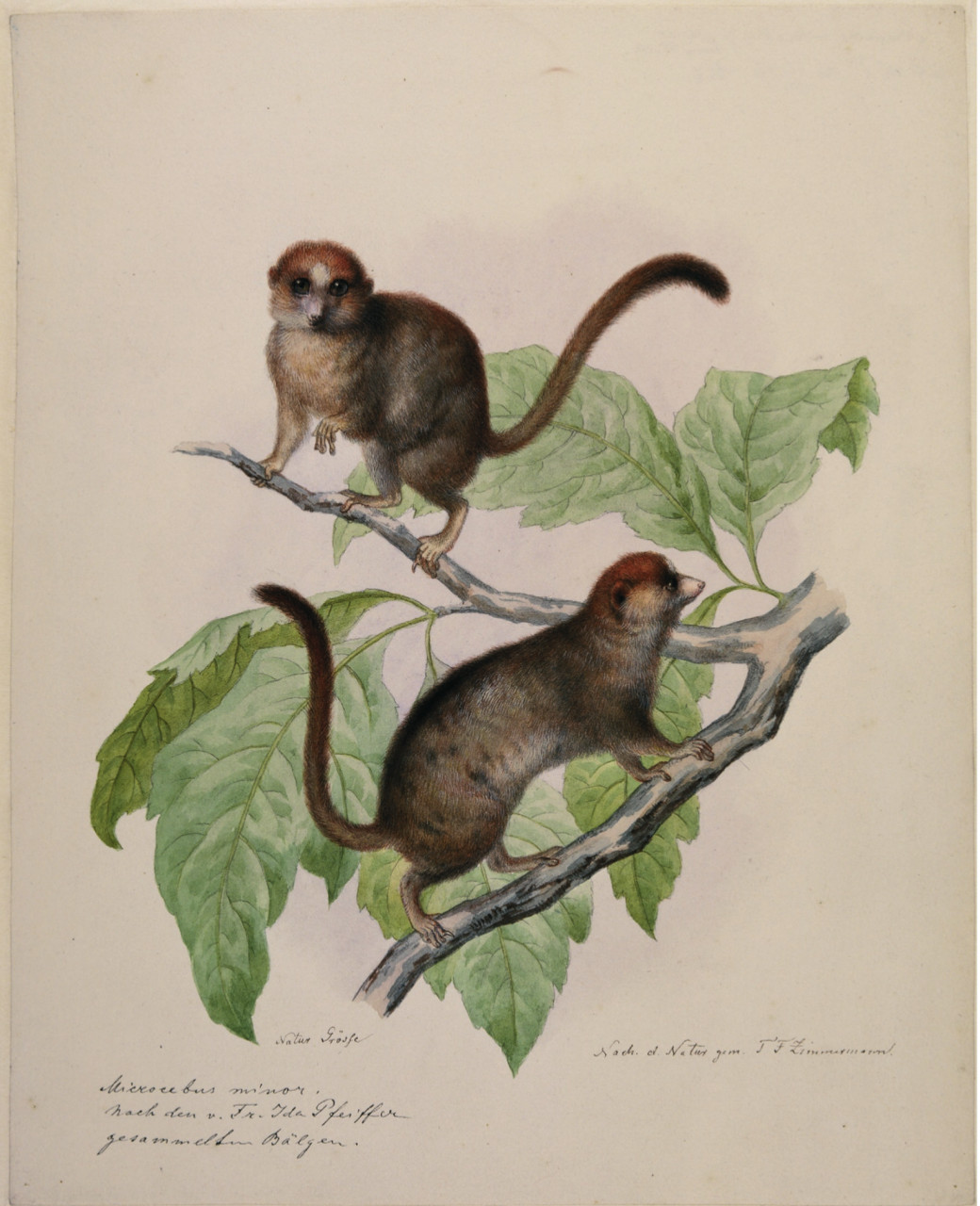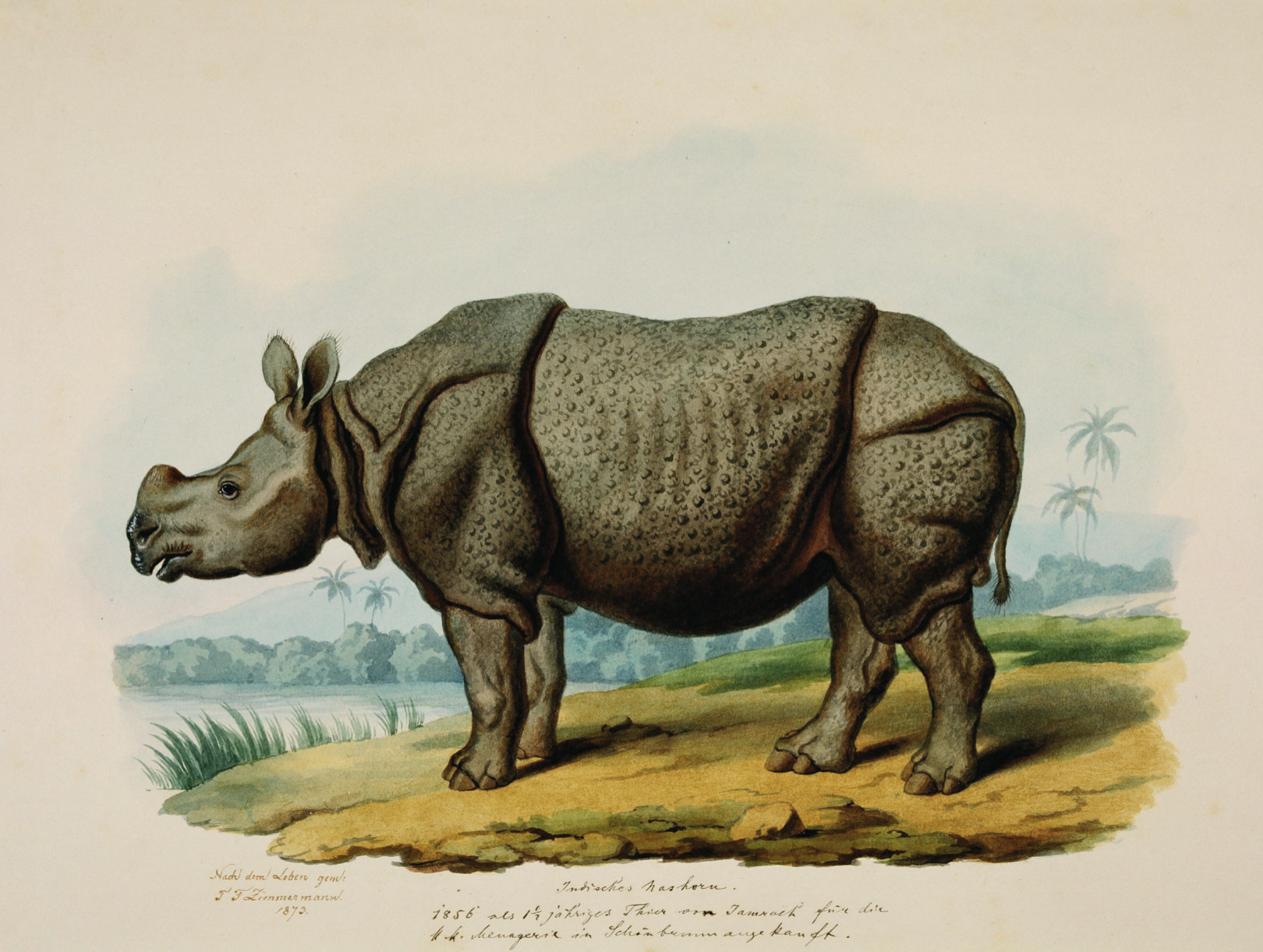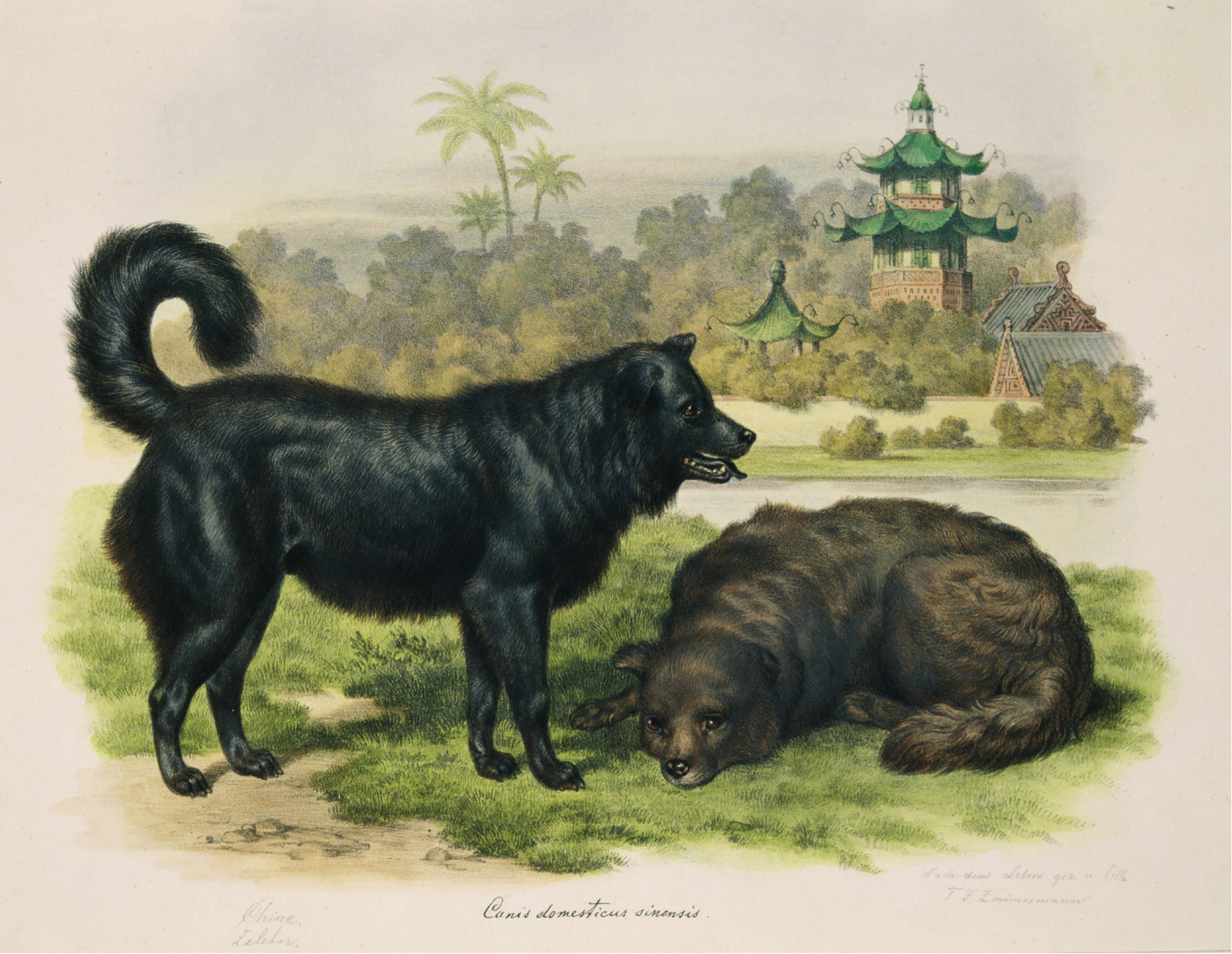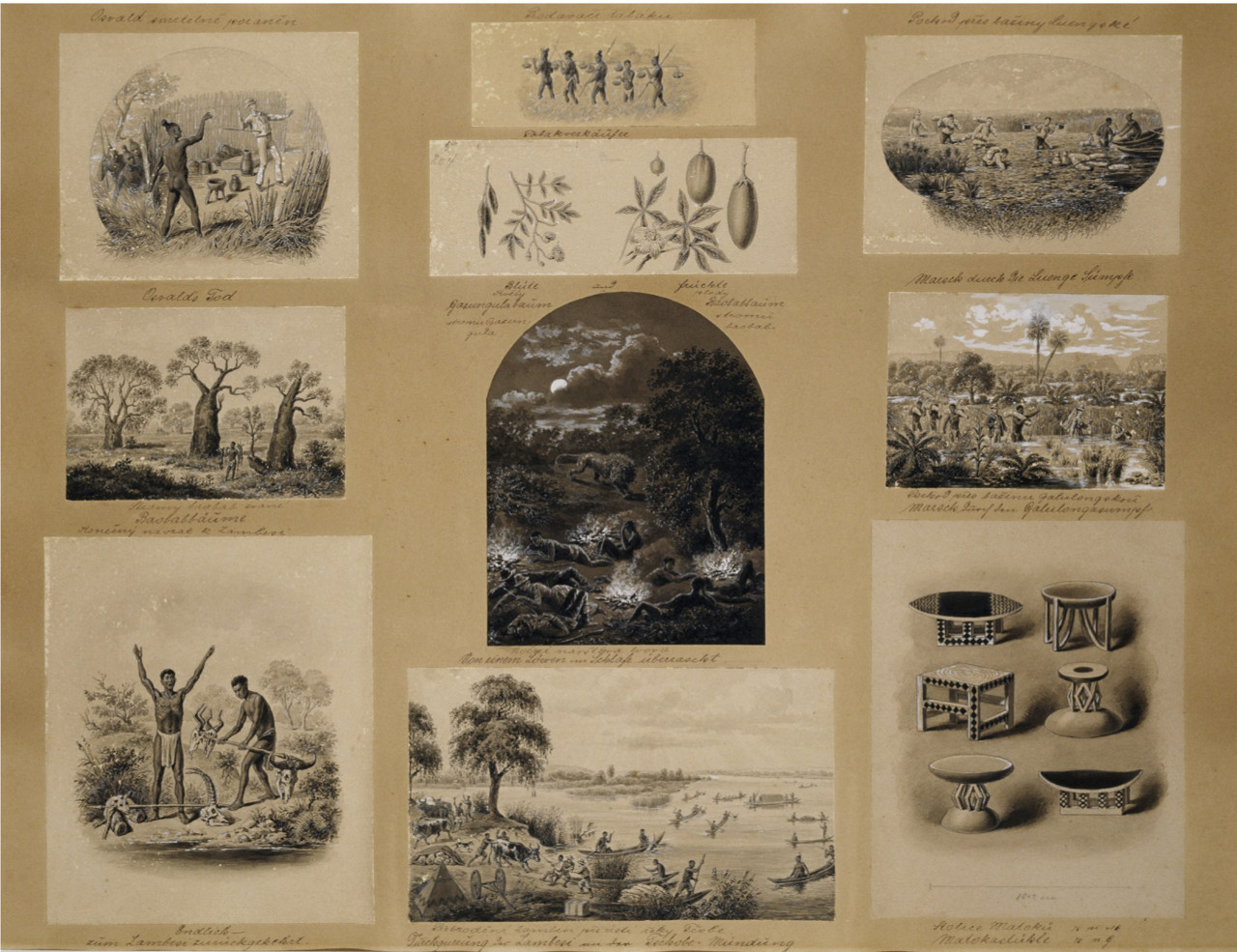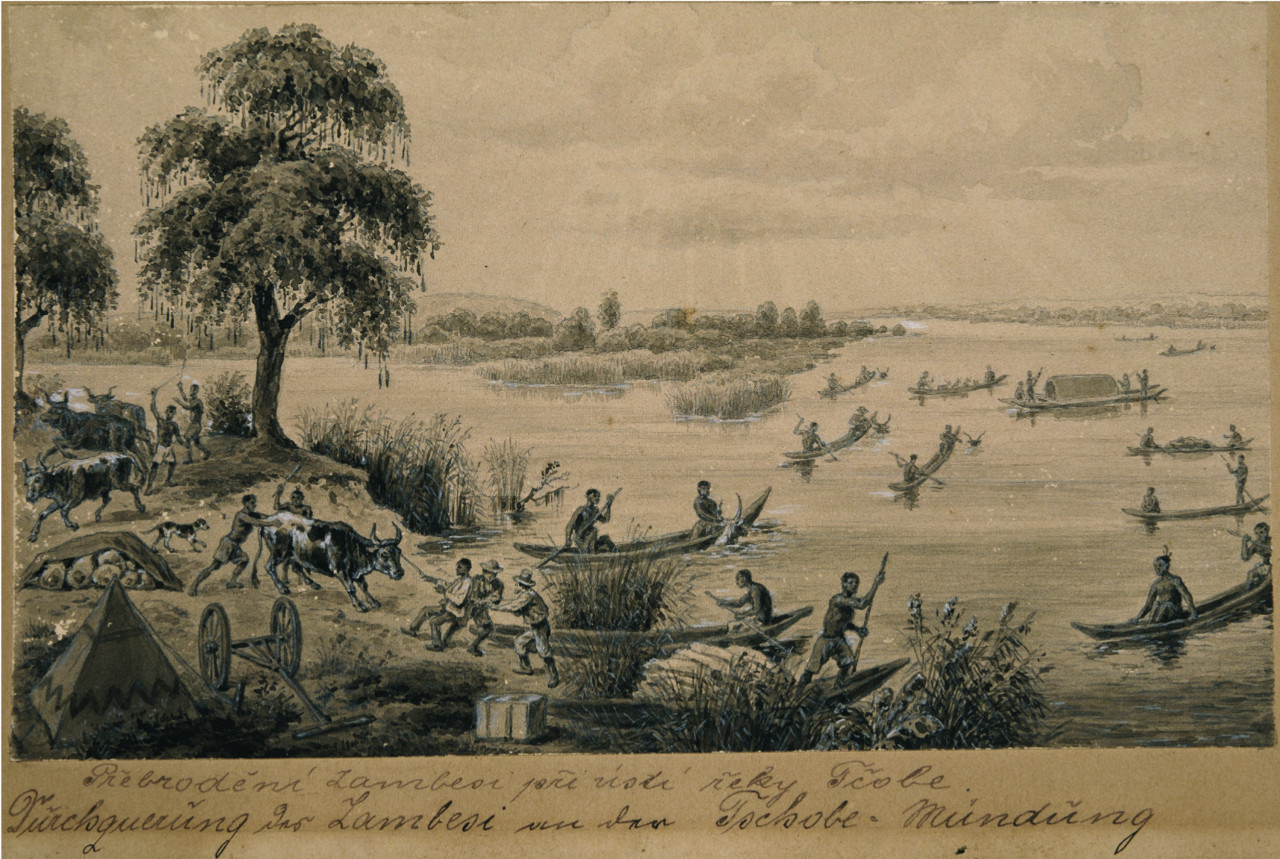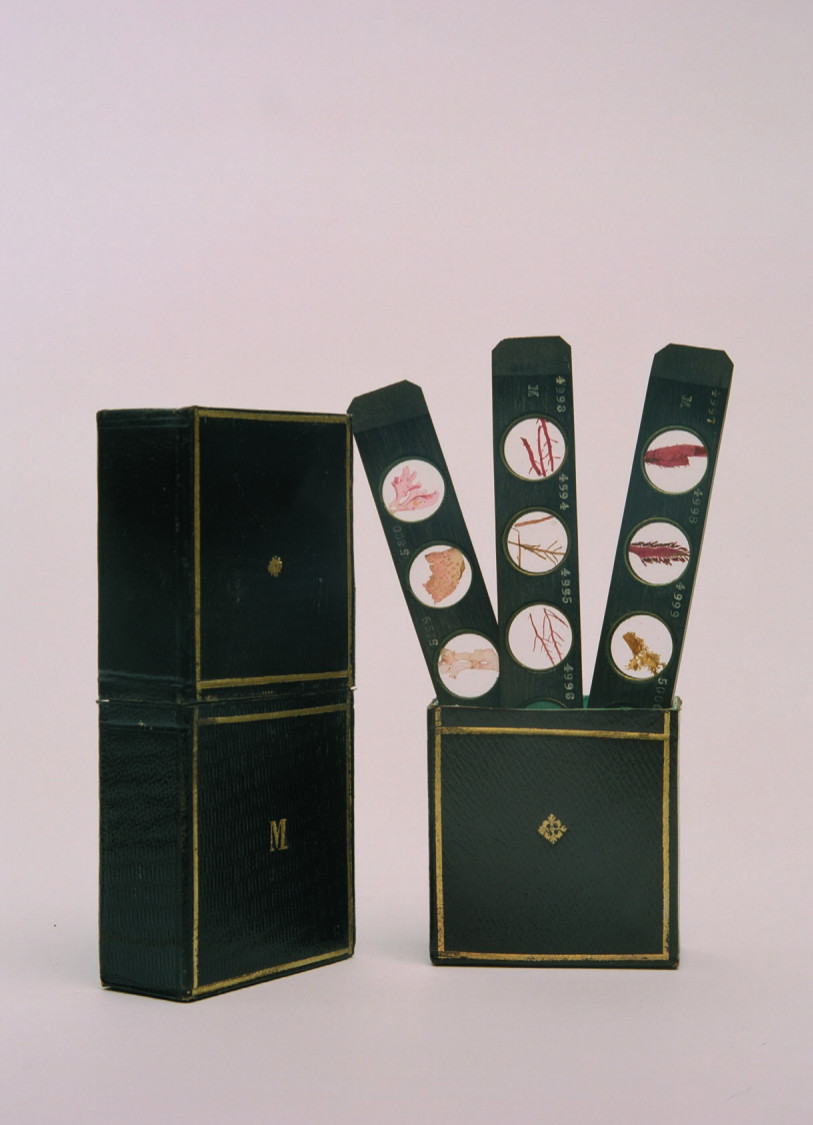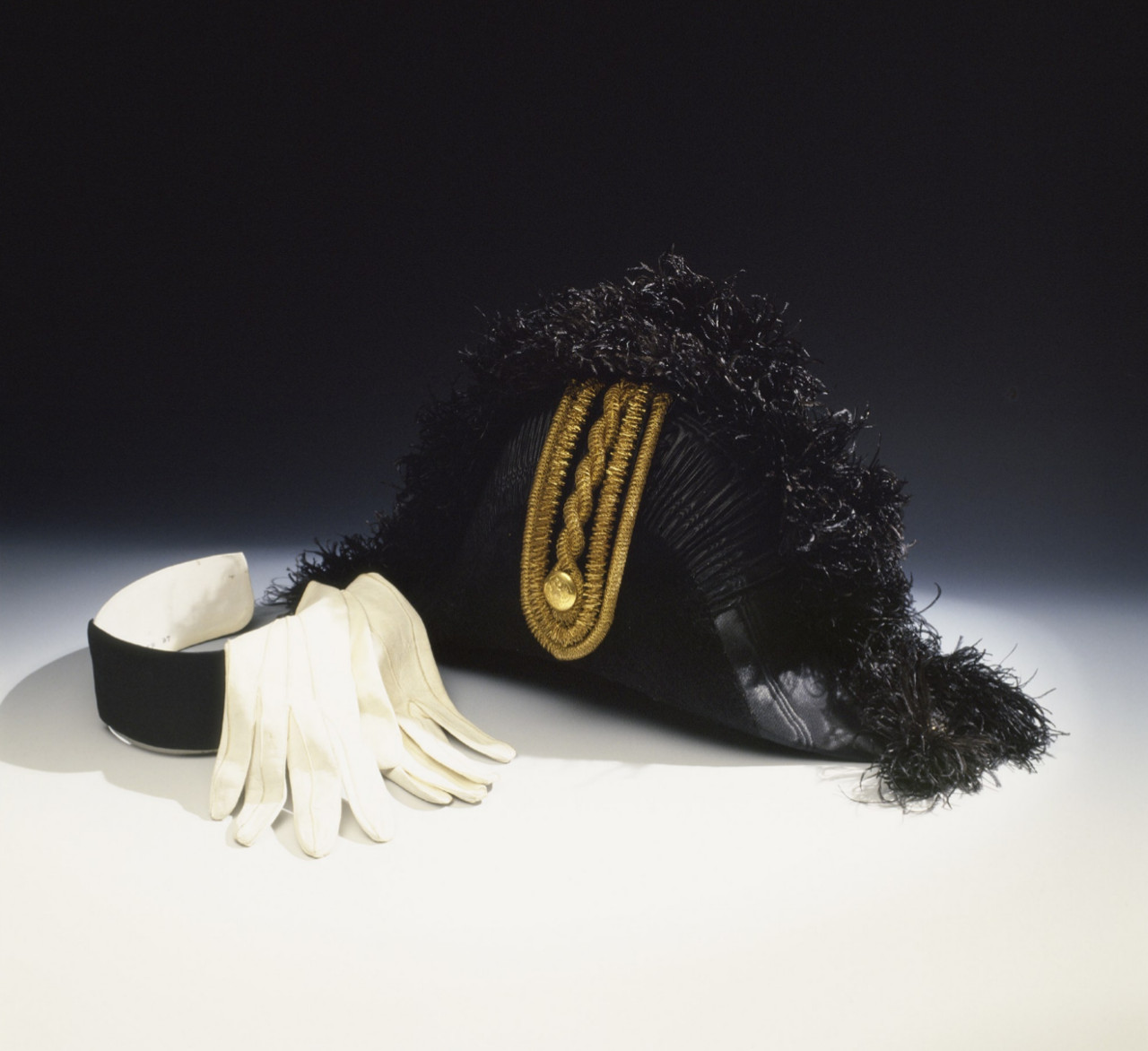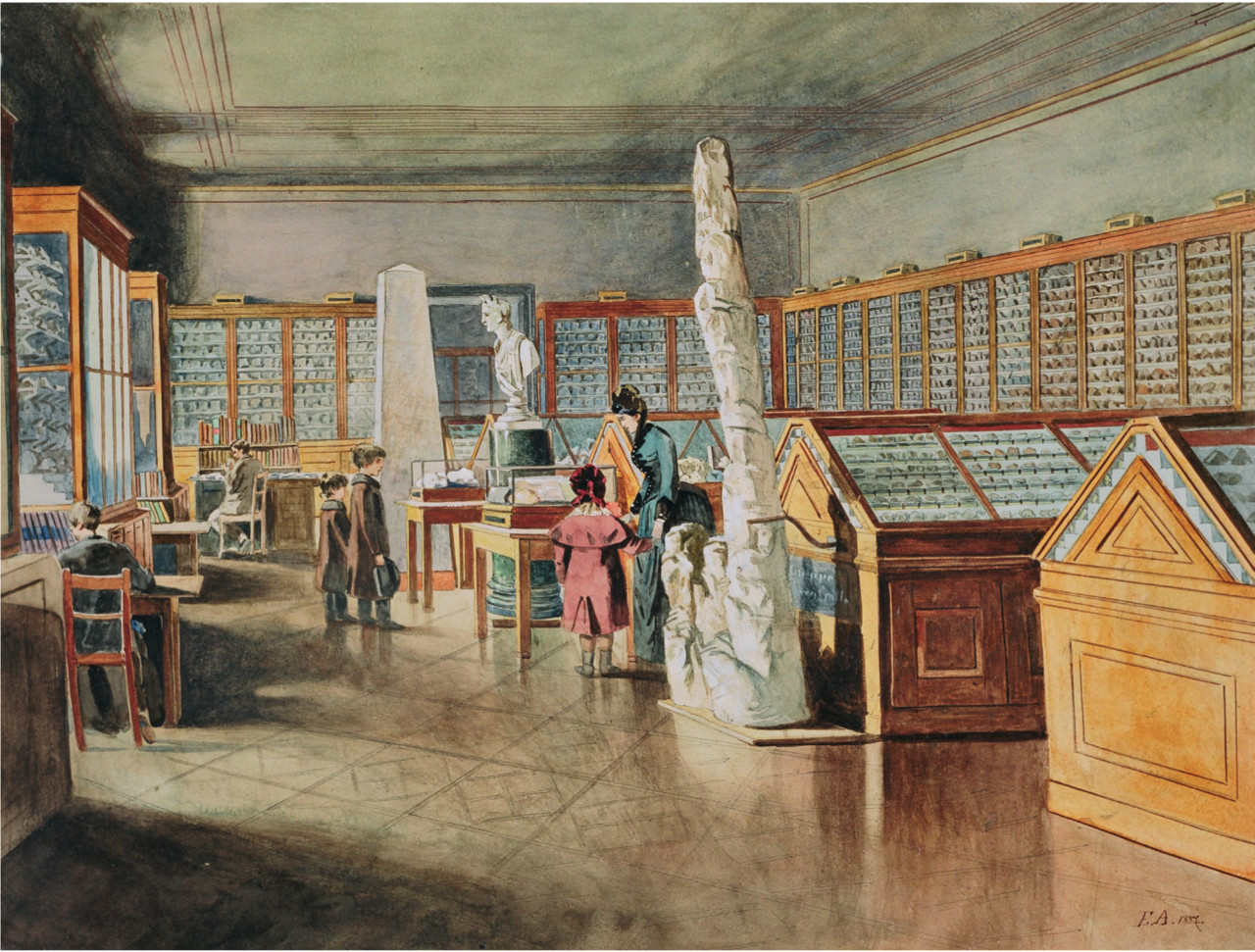Treasures from the Archives
Single print: The first giraffe in Vienna
In 1828 the Viennese painter, engraver and lithographer Eduard Gurk (1801 Vienna - 1841 Jerusalem) documented the arrival
of the first live giraffe in central Europe. Lithographs were made later and were widely circulated. The abnormal position
of the rear legs is striking, the cause of which was established to be two healed fractures of the upper thigh bones. These
injuries can be attributed to the way in which the giraffe was transported from Nubia to Cairo, tied to the back of a dromedary.
The Albanian adventurer, and later Turkish general, Mehmad Ali had declared himself Pasha of Egypt in 1811, and after terminating
his allegiance to the Sultan in 1827, he tried to find support in Europe for its independence. He had giraffes captured in
the area of present day Dafur in the Sudan. He sent one giraffe to London and one to Paris to win the favour of the royal
households there. The Austrian Consul-General in Egypt chose a female giraffe on the assumption that it would more easily
tolerate captivity. As this animal already fell ill before its departure from Alexandria, a male giraffe was brought from
Cairo. This giraffe had to spend the winter in Alexandria. On 30 March 1828, it was brought on board a merchant brig, together
with two cows, a calf and an Arab keeper, Ali Sciobary. The Austrian battleship “Artusa” escorted the brig to Venice. There
they were joined by an Austrian keeper, Josef Aman. The greater part of the rest of the journey was undertaken by foot. On
6 August the group arrived in Laxenburg, where the Emperor and his courtiers inspected the giraffe. A day later, the giraffe
moved into a compound specially made for him in the Schoenbrunn Zoo.
This exotic animal caused a real “giraffe mania” to break out in Vienna. The Viennese nibbled little giraffes made from sugar,
as well as giraffe cakes and pies. Giraffe patterns appeared on clothing materials. Giraffe themes decorated congratulatory
cards, hats, tobacco pouches, jewellery, plates, inkwells etc. The lady of society had problems climbing into her coach with
her “à la giraffe” hairstyle if it was modelled after the horns of the animal. There was even a perfume “Esprit à la Giraffe”
on offer. A “giraffe ball” took place in Penzing shortly after its arrival. One dance, the “giraffe gallop”, was specially
composed for the occasion. At the Imperial theatre in the Leopoldstadt, a play written by Adolf Bäuerle was presented: “The
Giraffe in Vienna, or Everything ‘à la Giraffe’”.
Despite every effort to care for him however, the giraffe died ten months later on 20 June 1829.
From the estate of Friedrich Simony
In 1898 Oskar Simony approached the director of the Imperial Natural History Museum and requested that he be allowed to bequeath
to the Museum the scientific estate of his father, who had died two years earlier, consisting of manuscripts, diaries, pictures
(from pencil drawings to watercolours), photographs, various prints etc. The office of the Lord Chamberlain, whose permission
had to be obtained at that time before a gift could be accepted, agreed to the transfer.
From 1836 Friedrich Simony (1813 Hrochowteinitz/Bohemia - 1896 St.Gallen/Styria), who was well-known for his research of the
Dachstein mountain, had studied natural sciences at the University of Vienna, following an apprenticeship as a pharmacist.
He already began his geomorphological and glaciological research of the Dachstein in 1840. He first climbed the mountain in
the winter of 1842 and a year later he twice spent the night on its summit. He climbed the mountain for the last time at the
age of 77 and worked until 1895 on a monograph (“The Dachstein region”, in 3 volumes). In 1851 his vocation led him to be
the first professor of geography in Austria, at the University of Vienna. At the same time he was active in such different
fields as glaciology, climatology, hydrology, ecology, astronomy, folklore, prehistory, plant geography and many others. He
also studied deserts, although he had only read about them. Unusually for a geographer, Simony never seemed to have the urge
to visit foreign countries. He never saw the sea and did not even get to know the other countries of the Monarchy. He was
almost 70 years old when he travelled to the Sudetan mountains for the first time.
For his innumerable pictures, some of which he created for teaching purposes, he used a variety of techniques: pencil and
ink drawings, watercolours, etchings and, later, photography. His pictures are executed with unbelievable accuracy in the
greatest detail. The large, 2.5m x1.6m watercolour “Glacier Phenomena” won prizes at two World Exhibitions, in London in 1862
and in Vienna in 1873. Even now his scientific observations represent an important basis for research in the Austrian Alps.
He maintained a close friendship with the discoverer of the Hallstatt burial grounds Johann Georg Ramsauer and with the writer
and painter Adalbert Stifter, who immortalized him in his novel “Indian Summer”. A great number of Alpine features are named
in honour of Simony and remind us of him until today, for example: Simony gap, Simony cave, Simony hut and the “Hotel Simony”
in the Dachstein region; and Simony peak, Simony glacier and Simony ridge in the Venetian mountain range.
The collection of Georg Ritter von Frauenfeld
In 1988, diplomas and decorations, scientific correspondence, excerpts, drawings of animals, watercolours of plants and mushrooms,
as well as 68 sketches by the painter Josef Selleny made on the „Novara“ expedition, from the estate of Georg Ritter von Frauenfeld
were bequeathed to the Department of Archives and History of Science by his Viennese relatives. Eleven years later the Department
received Frauenfeld’s diaries from his relatives in Berlin.
Georg Ritter von Frauenfeld (1807 - 1873 Vienna) earned his first wages as a builder, then moved to the postal service and
finally became a tutor and goods inspector in the service of Baron von Laudon. At the same time he continually educated himself
in the world of animals and plants. He gave much attention to the popularisation of the knowledge of natural history. Together
with Ignaz Rudolf Schiner, in 1851 he founded a zoologicalbotanical association (today the Zoological-Botanical Society) and
until his death supervised the secretarial matters associated with it. In 1852, at the age of 45, he was appointed fourth
curator of the Imperial Zoological collection with responsibility for the care of the molluscs. He owed his appointment to
his services to the association and his high recognition among scientists. He published over 250 works covering almost every
aspect of zoology and other branches of natural science. Many journeys on behalf of the natural history collection brought
him to, among other places, Egypt, Hungary, England, Ireland, Scandinavia, Switzerland and the Mediterranean region. In 1855
he married Wilhelmine, the 19-year-old daughter of his supervisor Vincenz Kollar, but this marriage already broke up in its
first year. As a zoologist, he took part in the sailing round the world of the frigate “Novara” 1857 - 1859. In the course
of this expedition he sketched and painted many plants and animals. In recognition of his services he was elevated by the
Emperor to a hereditary knighthood and decorated with the Order of the Iron Crown. He was the provisional head of the “Novara
Museum” in the Augarten, where the enormous acquisitions of the journey were stored and displayed until it closed in 1865.
At the same time, now as first Assistant-Curator, he looked after the Imperial mollusc collection. A few months before his
death he acquired the title “Imperial Councillor”.
On 18 November 1857 the Austrian frigate visited the volcanic island St. Paul. Humboldt had urged that this isle should be
more thoroughly researched. During a stay of nearly three weeks, Frauenfeld completed, among other things, pictures of rockhopper
penguins.
A special letter from Alexander von Humboldt
The correspondence and instructions of Alexander von Humboldt concerning the sailing round the world of the frigate Novara
(1857 1859) were given to the Natural History Museum in 1883. Vice-Admiral Bernhard Freiherr von Wüllerstorf-Urbair had bequeathed
them to the museum in his will.
A great many famous personalities, such as Johann Wolfgang von Goethe, Heinrich Hoffmann von Fallersleben, or Alexander von
Humboldt, are represented in these manuscripts with letters, scripts or poems.
On 7 April 1857 the important German natural scientist, known by his full name as Friedrich Wilhelm Heinrich Alexander von
Humboldt (1769 - 1859, Berlin), composed a letter to the captain of the Novara, WüllerstorfUrbair, after Archduke Ferdinand
Max, the initiator of the world-wide sailing and later Emperor Maximilian of Mexico, had requested him to provide scientific
instructions for this expedition. In his “Reflections on Physics and Geognostics”, which Humboldt incorporated in his letter,
he emphasised the value of geological research. He was particularly interested in volcanoes. The old man did not live to learn
the answer to his scientific inquiries, as he died a few months before the frigate’s return to Europe. With a certain premonition
he concluded his letter with the words:
“As I will long not be among the living when the frigate Novara returns to Trieste with scientific treasures, new knowledge
of dead and organic nature, of different human races, of customs and languages, I beseech God the Almighty that His blessing
may accompany this great and noble undertaking in honour of the common German fatherland. I am moved and excited in many ways
tonight (closing with these crooked and illegible scribbles) when I think of the period of life, now 58 years ago, when I
was in the beautiful gardens of Schönbrunn preparing for a great journey and enjoyed with gratitude the friendly goodwill
of the elderly Jacquin and Peter Frank.”
Drawings by Joseph Selleny
69 pictures - mainly pencil sketches - by the landscape painter Joseph Selleny (1824 Vienna, Meidling - 1875 Vienna, Inzersdorf),
which he produced during the voyage around the world made by the frigate “Novara” between 1857 and 1859, are contained in
the Frauenfeld collection given in 1988 to the Department of Archives and the History of Science.
Selleny graduated from the Art Academy where he studied under Thomas Ender, the head of the class for landscape painting,
the landscape painter Franz Steinfeld, the historical painter Leopold Kuppelwieser and the Professor of Anatomy, Anton von
Perger. Today Selleny is considered to be the best student of Thomas Ender, who had accompanied the Austrian expedition to
Brazil between 1817 and 1819 as a landscape painter. In 1847, one year after his graduation at the Academy, Selleny accompanied
Thomas Ender to Tyrol in the service of Archduke Johann. In Brixen he completed sketches for his painting “Desolated Cemetery”,
for which he received an award from the court. In 1854/55, with the help of this stipend, he was able to travel to Italy.
Not least because of the work he had done in Italy, Josef Selleny was invited by Archduke Ferdinand Max to document the journey
of the frigate “Novara” in pictures. Although there were cameras on board, and scientists had been trained to use them, no
photographs have ever been found.
In 1859/60 Selleny accompanied his patron Ferdinand Max to Brazil. For a short time he taught Crown Prince Rudolf to draw.
As well as a large number of paintings, in which the most important element for the painter himself was the landscape, although
the taste of the period considered this to be inferior to mythological scenes, Selleny was responsible for the pictorial decoration
of the Emperor’s villa in Bad Ischl, the basic planning for the layout of the Stadtpark in Vienna and, according to some sources,
the planning, at least in part, of the park at Miramar. In the last years of his life his health finally suffered from the
consequences of continuous overwork and he died at the age of 51, "mentally deranged", in a private sanatorium in Inzersdorf,
Vienna.
The animal painter Theodor Franz Zimmermann
Theodor Franz Zimmermann was a well-known painter of landscapes and animals, particularly horses and hunting scenes, and graduated
from the Vienna Academy. Between 1839 and 1858 his pictures were often to be seen in its exhibitions. Zimmermann was born
in 1808 in Nassereith in Tyrol. He lived until his death in 1880 in Vienna, where he worked in his studios, which he often
changed. From 1855 very many of his pictures were commissioned for the Imperial Zoological Collection. Often the only model
he had for an animal was its coat. To paint the habitat of an animal based only on its coat was extremely difficult, especially
as painters at that time had hardly ever actually seen the animals. Consequently, many animals were described by natural scientists
as a new species because of inaccurate representations and this had to be corrected later. This was never the case, however,
with the pictures of animals painted by Zimmermann. In this way he painted the animals brought back from Madagascar by Ida
Pfeiffer (1797 - 1858) from her last journey in 1857, such as the roughly 29 cm. long, russet mouse lemur Microcebus rufus.
“Actual size” and “Microcebus minor. From the coats collected by Frau Ida Pfeiffer” are noted on the sheet
Ida Pfeiffer was one of the most fascinating female personalities of the 19th century. She only began to travel at the age
of 45, after her sons had grown up, and then was almost continuously on the move until she died. She was a woman who financed
her journeys and her living costs from publications describing her experiences and from the sale of the zoological, botanical
and ethnographic items she had collected on her travels. Neither accidents nor illnesses prevented this woman, who was highly
considered by Alexander von Humboldt and by the geographer Carl Ritter, from covering a total of 240,000 kilometres by sea
and about 32,000 kilometres by land. She was also in parts of the world that no European had seen before.
In 1872 Zimmermann drew and painted from life an Indian rhinoceros, which had been purchased in 1856 by the Imperial Menagerie
in Schönbrunn from Jamerach, a London firm of animal dealers. He also completed his picture, a coloured lithograph Canis domesticus
sinensis, using a living dog. The “Chinese house dogs” came from Hongkong and had been brought back from the “Novara Expedition”
by Johann Zelebor, who was responsible both for the preservation of dead animals and the capture and transport of living ones
for Schönbrunn. Zimmermann drew the brown specimen following information provided by Zelebor, who had been promoted to custodian
of mammals in the natural history collection.
From the estate of Emil Holub
Twenty years ago, documents such as letters, postcards, a scrapbook, copies of correspondence, and photographs, as well as
original drawings from the estate of Emil Holub and his wife Rosa, née Hoff (1865 - 1958), were transferred to the Department
of Archives and History of Science, first on loan and later as a gift.
In 1872, a few months after qualifying as a medical doctor, Emil Holub (1847 Holice, Bohemia - 1902 Vienna) set off on his
first journey to South Africa. At first he worked as a doctor in the diamond region of Kimberley in order to earn funds for
expeditionary travel in the north of the country. His first three expeditions (1872 - 1879) took him through the rand regions
of Transvaal, Bechuanaland and Matabeleland, to the source of the Limpopo river and into the Marutse-Mambunda Kingdom, to
the Zambezi river and the Victoria Falls. In 1879 he brought a rich haul of zoological and ethnographical items to Prague,
where some of his 30,900 specimens were soon afterwards on show. One year later they could be seen in Vienna. Holub donated
his collections to 113 museums, scientific institutions and schools. He then planned to cross Africa from Cape Town to Cairo.
He would then be able to research the geography of the largely unknown regions north of the Zambezi and establish a scientific
collection. Another objective was to encourage Austrian commerce to be more active in South Africa. He sought sponsors for
this expedition by lecturing.
Together with his wife Rosa, who was only 18 years old, and six men who were trained in preserving specimens, repairing firearms
and building boats, he set off in 1883 on a journey into central South Africa. This expedition into the “unknown land of Mashukulumbe”
(the Ila tribe in the Kafue region in Zambia) proved to be extremely difficult. At the end of August 1887 the Holubs travelled
back to Vienna with what until then was the largest collection of objects from Africa. 86 railway trucks were packed with
ethnographic specimens, minerals, rocks, plants, animals - from mammals to the smallest insects - as well as animals for the
zoos. Holub failed to realize his wish to create an African museum. So again he gave away his collections to 200 museums,
institutes and schools. In addition to smaller publications on ornithology, ethnology, geography, economy and fossils, he
published books describing his African travels. The publication “From Cape Town into the land of the Mashukulumbe” (Vienna,
1890, in two volumes) covers his second adventurous expedition. He himself made the models for the woodcut illustrations to
his book. The explanatory notes to the pictures are in German and Czech.
Physical Objects
In the Federal law gazette for the Republic of Austria in 2002 the regulation governing the administration of the Natural
History Museum was published. Paragraph 9 laid down the functions of the Department of Archives and History of Science. In
addition to the appraisal, preservation, exploitation and scientific evaluation of the written and graphic material from all
departments, “other materials which are not required for the actual work of the departments” are also covered. It should be
explained here that the storerooms also contain collections of physical objects. From printing blocks to old typewriters and
cameras, utensils are kept in custody, some of which give the impression of being curiosities, such as a portable toilet,
water jugs, bricks remaining from the laying of the foundation stone of the museum, as well as small dioramas and parts of
the full-dress uniform of a museum attendant from about 1900.
Of particular value are the microscopic specimens which Emperor Ferdinand I, “the good” (1793 - 1875), produced himself. Twice
a week the Emperor received instruction in the study of plants from the Professor of Botany, Stefan L. Endlicher (1804 - 1849).
Ferdinand was mainly interested in the more primitive plants – algae, mushrooms, lichen and moss. He also learnt how to examine
these under a microscope. He succeeded in forming an almost friendly relationship with the Viennese optician Oskar Plössel,
who had just developed a new microscope and was considered to be a very difficult character. The Emperor himself prepared
thousands of microscopic specimens of primitive plants, as well as of the scales of fish and butterflies, minerals etc. Most
of these are of the highest quality and for this reason until 20 years ago they were still on show in the museum for instructional
purposes.
Preliminary Paintings
The Department holds in its custody documents concerning the history of the building of the museum and its interior decoration,
together with relevant illustrations. Everything from postcards and pencil sketches to aerial photographs are to be found
here. Depictions such as those of the animal collection at the Josefplatz, the Imperial botanical collection on the Rennweg
and the old mineral collection in the Augustinergang throw light on the history of the institutions which were forerunners
of the Natural History Museum.
The landscape painter Eduard Ameseder (1856 Czernowitz - 1938 Vienna) had been a pupil of the Academy of Fine Arts since 1876.
From 1887 to 1891 he continued his studies in Karlsruhe under Gustav Schönleber (1851 - 1917). After staying in Munich for
one year Ameseder worked in Vienna again from 1893. A great number of the illustrations in the volume “The Austrian-Hungarian
Monarchy in word and picture” are attributable to him. In 1887 Ameseder was commissioned by the Imperial Natural History Court
Museum to create two oil-paintings, which depict the first and fourth rooms of the old mineral collection in the Augustinergang.
These were then shown in Room V, today the Meteorite Room. As a model for his pictures he first completed watercolours. The
accompanying illustration shows the painting “First Room of the Imperial Mineral Collection” with its group of stalactites
and large pyramid of salt. In the background, sitting at his desk, the later Director of the Department, Friedrich Martin
Berwerth (1850 - 1918), then an assistant, can be seen, and in the foreground, Wenzel Wennisch, a day-worker and former chamberlain
of Emperor Maximilian in Mexico,. The two children in the middle of the picture are the two younger sisters of the painter.
Next to the stalactites is Emmy Berwerth, maiden name Frankel, the niece of Eduard Suess, with Luise, the youngest daughter
of the senior ship-building engineer, Karl Kúzmany. After the painting was lost in the showroom, a watercolour by the painter
Fahrid Sabha, born in Vienna in 1962, served as a model in 1983/84 for a new version of this work to be commissioned. Beyond
the central significance to the museum of the collections themselves, these pictures clearly demonstrate the continuous unity
between these objects and the place, with its artistic setting, where they are stored.
E. Ameseder, erster Saal des k.k. Mineraliencabinet, 1887 (c) Naturhistorisches Museum Wien

